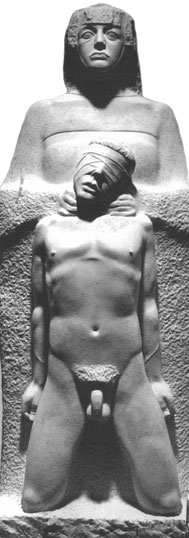David McFall R.A. (1919 - 1988)
Sculptor





1972/5 Oedipus and Jocasta 
Layrs roche stone
Height 91"
Exhibited Royal Academy Summer Exhibition 1972 Catalogue No. 1153
Royal Academy Summer Exhibition Illustrated Magazine 1972 page 27
At West N orwood Library, London
orwood Library, London
This work was finished on 15th March 1972 and used the part of the stone block left over from carving Balfour (1962/1) [originally intended for the Earl Lloyd George statue to be carved by Sir Jacob Epstein who had died]
Reference: The Monument and Sculpture Association National Recording Project records:
Oedipus and Jocasta, Sculpture, West Norwood Library, Norwood High Street. Work ID 1077; Manual Reference CLLH/71. It took McFall 10 years to conceive and carve from a piece of French limestone given to him by Jacob Epstein. He has given the sculpture to Lambeth.
The myth: Oedipus was the son of Laius and Jocasta. Before his birth it was prophesied
that he would murder his father. To avoid this calamity, the child was given to a
herdsman who was told to kill him. The herdsman, out of pity and yet fearing to disobey,
instead gave him to another herdsman, tying his feet together and piercing them with
a stake. The herdsman took the infant Oedipus to his master, the king of Corinth,
Polybus, who adopted him as  his own son.
his own son.
Many years later Oedipus is told that he is not the son of Polybus. To confirm this,
he seeks help from an oracle and is told that he is destined to kill his father and
mate with his mother. In his attempt to evade the dictates of the oracle, he decides
to flee from home to Thebes on the other side of the mountains. As Oedipus was travelling
by horse to Thebes, he came to a crossroads where he met a chariot, which, unbeknownst
to him, was driven by Laius, his true father. A dispute arose over right of way,
and the outcome was that Oedipus killed Laius. Continuing his journey to Thebes,
Oedipus encountered the Sphinx, who stopped any traveller and asked him a riddle
that none had yet been able to solve. If the traveller failed, he was eaten by the
Sphinx. The riddle was “What walks on four feet in the morning, two in the afternoon
and three at night?" The answer was “Man." Oedipus solved the riddle, and the Sphinx
threw herself to her death. The gratitude of the Thebans led them to appoint Oedipus
as their king. Oedipus was also given the widow Jocasta (who was also his mother)
as his wife. Over the years, Oedipus and Jocasta had four children – two son s, Polynices
and Eteocles and two daughters Antigone and Ismene.
s, Polynices
and Eteocles and two daughters Antigone and Ismene.
Many years after the marriage of Oedipus and Jocasta, a plague struck the city of Thebes. Oedipus, with his typical hubris, asserted that he could and would end the plague. He sent Creon, Jocasta's brother to the Oracle at Delphi seeking guidance and finds that the murderer of Laius must be found and either killed or exiled. In a search for the identity of the killer, Oedipus sends for the blind prophet Tiresias, who warns him not to try to find the killer. In an angry exchange, Tiresias tells Oedipus that he is the killer and suggests that he is living in shame and doesn't know who his true parents are. Undaunted, Oedipus continues his search. When a messenger arrives from Corinth with the news that Polybus is dead, Oedipus still worries about the prophecy that he will mate with his mother. The messenger reassures him with the news that he is adopted. Jocasta then realizes who Oedipus is and goes in to the palace to kill herself. Oedipus seeks verification of the messenger's story from the very same herdsman who was to have left Oedipus to die as a baby. From that herdsman, Oedipus learns that the infant raised as the adopted son of Polybus and Merope was the son of Laius and Jocasta. Thus, Oedipus finally sees that at the crossroads he had killed his own father, and then he had married his own mother, Jocasta.
Oedipus goes in search of Jocasta and finds she has killed herself. Taking brooches from her gown, Oedipus blinds himself. Oedipus leaves the city, and his daughter Antigone ac ts as his guide as he wanders blindly through the country, ultimately dying at Colonus, after being placed under the protection of Athens by Theseus, its king.
All rights reserved
| Animals |
| Busts and Heads |
| Children |
| Churchill studies |
| Lettering |
| Medals coins plates |
| Reliefs |
| Stone carvings |
| Contemporary British Artists |
| On Epstein |
| Picasso |
| The art of portrait sculpture |
| Letters |
| Palliser |
| Son of Man |
| Press |
| Obituaries |
| Memorial address |